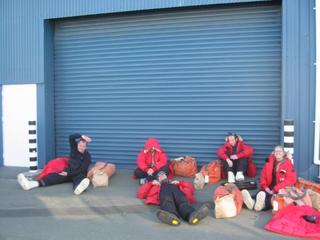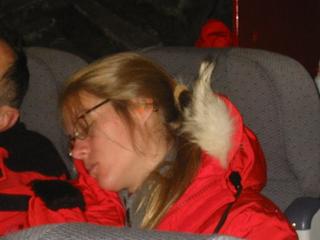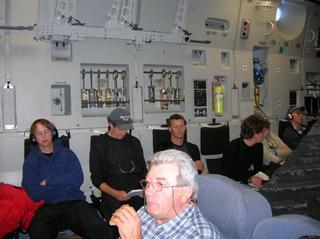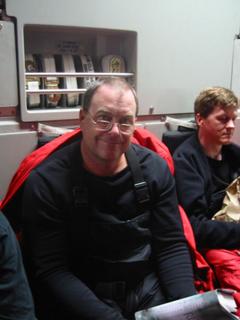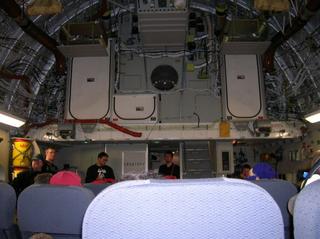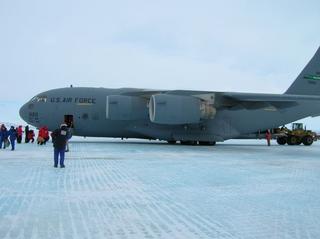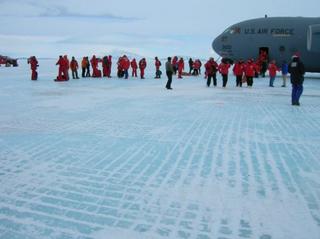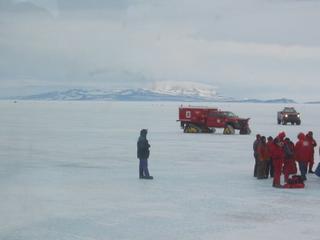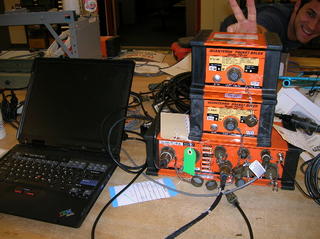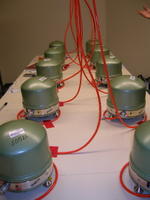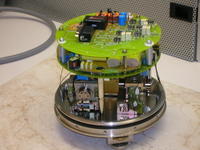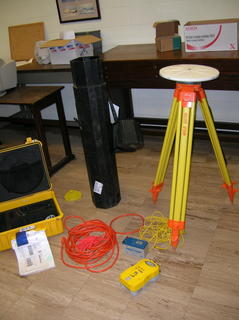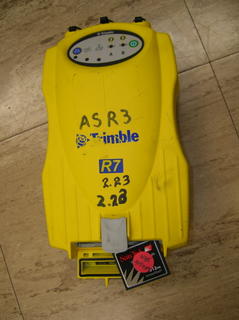Happy Camper
So, I had finally arrived in Antarctica. Once we got off of the plane, we were driven to McMurdo station, which is a very short drive. We then got our room assignments. My roommate is named Olga, and she is also part of our team that studies icebergs.
That was on Friday, October 14th. The following Tuesday I went to “Snow School” or “Happy Camper”. Basically, it is a two-day lesson on how to survive in Antarctica if I got lost, or our planes crash or we get stuck in a bad storm or any other catastrophe you could imagine that could happen someplace as cold and isolated as Antarctica. It is a fairly small school, I think about 18 students with two instructors.
We spent the morning learning about hypothermia and frostbite. I learned that we lose 2-3 liters of water through respiration per day! In Antarctica, one of the fastest ways to become hypothermic is to get wet, because if we spill water on ourselves, it will freeze very quickly. So we learned that it is very important to not sweat, because the sweat will get cold so quickly. Can you imagine trying to do something like shovel snow and not get sweaty?
We also learned that the best way to stay warm is to “eat, drink, and be merry”. It is normal to eat 6000 calories a day here if you are going to be doing strenuous activity! Our body burns much more heat to stay warm in the cold, which is why it is important to keep your body fueled.
After the morning lessons, we drove onto the ice-shelf for camping. We learned how to use camping stoves in order to make water from the snow. We also learned how to carve snow blocks to build walls, and we put up several tents. We need a snow wall to protect ourselves from the wind and snow drifts. The wall went all the way around our camp when we were done! (It actually only took a few hours to put the entire camp up, which is surpringly short).
Here I am are lugging the snow blocks (when the weather got bad, we started stealing them from the previous camp sites). In the background, you can see a piece of rock. It is called Castle Rock, and people hike there. You have to be very careful when hiking to always stay on a marked trail. The path to that rock has many cravasses, and a few years ago a woman ran off the trail, fell in one, and died. So you have to be very careful to only walk on marked paths!
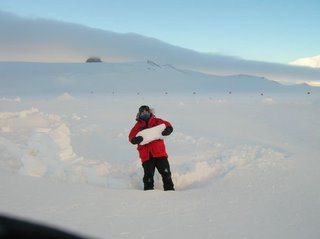
My favorite thing we learned was how to make a “quinnzie” (I honestly don’t know if I am spelling that right). To make a quinnzie, we piled up all of our duffel bags in a huge pile and covered them with a tarp and then a foot and a half of snow. We packed it down, and then dug a hole at the base to pull out the duffel bags. The place where the bags had been was now a small room!
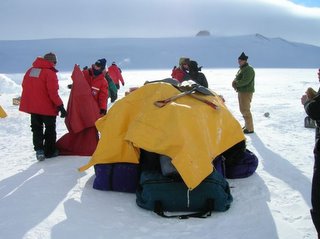

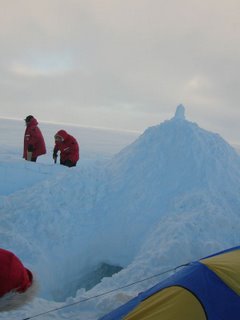

The picture above is of our camp, just about finished. You can see lots of the tents, the quinnzie, and the snow wall we built. When we were camping, it got pretty cold; I think maybe -20 F. It also got very windy at one point. Those were slightly scary times, because it was hard to catch your breath in the cold. But everyone was very nice, and we always had hot water to make hot chocolate. When you went inside of the Scott tents (the two very tall tents) it was nice and warm from the camp stoves.
I always had to go to the bathroom a lot, and since we are outdoors, normally people just have a yellow pole to go to the bathroom at. But since this school is taught several times a year, it has an outhouse. I may have seen many incredible things in Antarctica, but I honestly think the strangest feeling I’ve had since coming here is walking into an outhouse that has no spiders in it. I guess in the US outhouses are always in the woods and full of ‘em, you know? But I have not seen any wildlife at all in Antarctica, not even a fly or spider!
We had also set up many tents, but I really wanted a chance to sleep in the quinnzie because it is different. There were room for three people, and I was one of them! It was great! We brought the small stove into it, and made our dinner. It was very quiet, we could hear people walking outside (snow crunching) but we couldn’t hear anyone talking. The next morning, we were the last people to wake up! These are pictures from inside the quinnzie. The picture of me is actually in the doorway, which is dug into the ground, so you have to slide up it to get inside. Next to my head is the pot which we made water from. The other two people are Jesse and Luke, who also slept in the quinnzie. Luke is from New Zealand, so it was fun meeting someone from so far away. They are both part of a team called “ANDRILL” who are drilling cores to study. It is a huge, many nation project and they even had a TV crew filming them while we were at camp! (Even the people who were filming took the school, so they were all shoveling, too!)
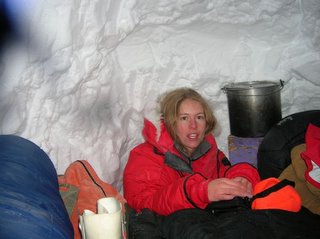
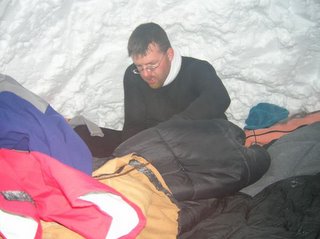
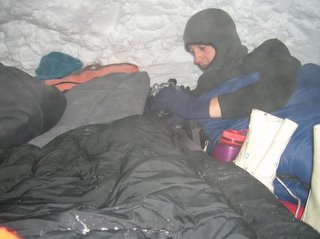
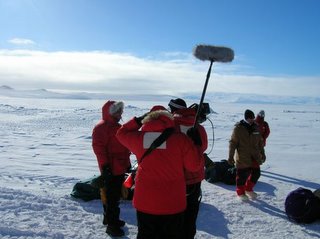
It was interesting sleeping outside, since the sun doesn’t set. Even though the snow walls of the quinnzie were over a foot thick, you could see perfectly clearly in the middle of the night. I pulled my sleeping bag right over my head, and I wasn’t even cold, except for my water bottle, which you sleep with so it doesn’t freeze. That was really cold. But a lot of the people who’d slept in tents didn’t do as well, and spent a lot of the night awake.
Doug, the head of our iceberg team, decided to make something called a “snow trench” which basically looks like a coffin, in my opinion. Here we are making it. We dug a small trench in the ground and then covered it with an A-frame of snow blocks.
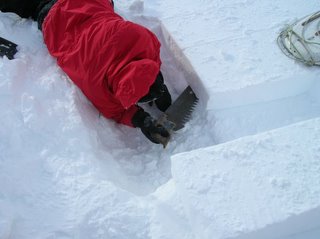
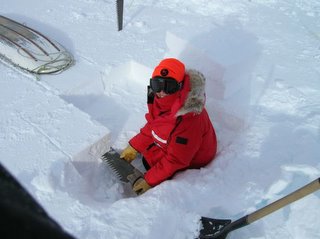
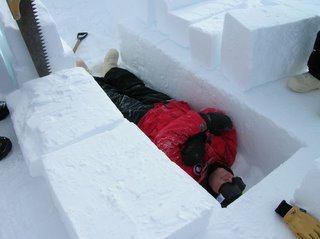
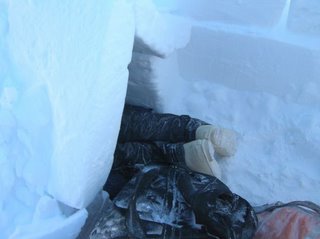
The last picture above is Doug crawling into the snow trench. You can see how tight it is! He stayed there the entire night. I was very impressed, because it is small and scary looking.
Here we are the next day! Mount Erebus is behind us, which is an active volcano! On clear days, you can see it smoking, which is really cool.
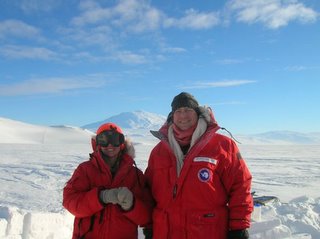
The next day we learned how to use radios, and got to head back to McMurdo station. All in all, it was a very fun camping trip!
I spent much of that first week in meetings. I even learned how to drive the trucks up here, which have wheels that look like a tank. It was the fastest driving test I’d ever had! I just had to drive down the road and back. And we spent a lot of time making sure our seismic equipment and GPS equipment were working (we are still doing that today, even two weeks later!). Snow School was a lot of fun because I really got to know people who were staying at McMurdo.
That was on Friday, October 14th. The following Tuesday I went to “Snow School” or “Happy Camper”. Basically, it is a two-day lesson on how to survive in Antarctica if I got lost, or our planes crash or we get stuck in a bad storm or any other catastrophe you could imagine that could happen someplace as cold and isolated as Antarctica. It is a fairly small school, I think about 18 students with two instructors.
We spent the morning learning about hypothermia and frostbite. I learned that we lose 2-3 liters of water through respiration per day! In Antarctica, one of the fastest ways to become hypothermic is to get wet, because if we spill water on ourselves, it will freeze very quickly. So we learned that it is very important to not sweat, because the sweat will get cold so quickly. Can you imagine trying to do something like shovel snow and not get sweaty?
We also learned that the best way to stay warm is to “eat, drink, and be merry”. It is normal to eat 6000 calories a day here if you are going to be doing strenuous activity! Our body burns much more heat to stay warm in the cold, which is why it is important to keep your body fueled.
After the morning lessons, we drove onto the ice-shelf for camping. We learned how to use camping stoves in order to make water from the snow. We also learned how to carve snow blocks to build walls, and we put up several tents. We need a snow wall to protect ourselves from the wind and snow drifts. The wall went all the way around our camp when we were done! (It actually only took a few hours to put the entire camp up, which is surpringly short).
Here I am are lugging the snow blocks (when the weather got bad, we started stealing them from the previous camp sites). In the background, you can see a piece of rock. It is called Castle Rock, and people hike there. You have to be very careful when hiking to always stay on a marked trail. The path to that rock has many cravasses, and a few years ago a woman ran off the trail, fell in one, and died. So you have to be very careful to only walk on marked paths!

My favorite thing we learned was how to make a “quinnzie” (I honestly don’t know if I am spelling that right). To make a quinnzie, we piled up all of our duffel bags in a huge pile and covered them with a tarp and then a foot and a half of snow. We packed it down, and then dug a hole at the base to pull out the duffel bags. The place where the bags had been was now a small room!




The picture above is of our camp, just about finished. You can see lots of the tents, the quinnzie, and the snow wall we built. When we were camping, it got pretty cold; I think maybe -20 F. It also got very windy at one point. Those were slightly scary times, because it was hard to catch your breath in the cold. But everyone was very nice, and we always had hot water to make hot chocolate. When you went inside of the Scott tents (the two very tall tents) it was nice and warm from the camp stoves.
I always had to go to the bathroom a lot, and since we are outdoors, normally people just have a yellow pole to go to the bathroom at. But since this school is taught several times a year, it has an outhouse. I may have seen many incredible things in Antarctica, but I honestly think the strangest feeling I’ve had since coming here is walking into an outhouse that has no spiders in it. I guess in the US outhouses are always in the woods and full of ‘em, you know? But I have not seen any wildlife at all in Antarctica, not even a fly or spider!
We had also set up many tents, but I really wanted a chance to sleep in the quinnzie because it is different. There were room for three people, and I was one of them! It was great! We brought the small stove into it, and made our dinner. It was very quiet, we could hear people walking outside (snow crunching) but we couldn’t hear anyone talking. The next morning, we were the last people to wake up! These are pictures from inside the quinnzie. The picture of me is actually in the doorway, which is dug into the ground, so you have to slide up it to get inside. Next to my head is the pot which we made water from. The other two people are Jesse and Luke, who also slept in the quinnzie. Luke is from New Zealand, so it was fun meeting someone from so far away. They are both part of a team called “ANDRILL” who are drilling cores to study. It is a huge, many nation project and they even had a TV crew filming them while we were at camp! (Even the people who were filming took the school, so they were all shoveling, too!)




It was interesting sleeping outside, since the sun doesn’t set. Even though the snow walls of the quinnzie were over a foot thick, you could see perfectly clearly in the middle of the night. I pulled my sleeping bag right over my head, and I wasn’t even cold, except for my water bottle, which you sleep with so it doesn’t freeze. That was really cold. But a lot of the people who’d slept in tents didn’t do as well, and spent a lot of the night awake.
Doug, the head of our iceberg team, decided to make something called a “snow trench” which basically looks like a coffin, in my opinion. Here we are making it. We dug a small trench in the ground and then covered it with an A-frame of snow blocks.




The last picture above is Doug crawling into the snow trench. You can see how tight it is! He stayed there the entire night. I was very impressed, because it is small and scary looking.
Here we are the next day! Mount Erebus is behind us, which is an active volcano! On clear days, you can see it smoking, which is really cool.

The next day we learned how to use radios, and got to head back to McMurdo station. All in all, it was a very fun camping trip!
I spent much of that first week in meetings. I even learned how to drive the trucks up here, which have wheels that look like a tank. It was the fastest driving test I’d ever had! I just had to drive down the road and back. And we spent a lot of time making sure our seismic equipment and GPS equipment were working (we are still doing that today, even two weeks later!). Snow School was a lot of fun because I really got to know people who were staying at McMurdo.

